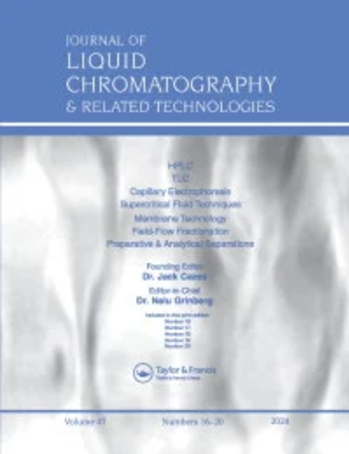An HP-TLC densitometric method and fingerprinting for estimating capecitabine and thymoquinone simultaneously and its application in nanoscience using Box–Behnken design
IF 1.2
4区 化学
Q4 BIOCHEMICAL RESEARCH METHODS
Journal of Liquid Chromatography & Related Technologies
Pub Date : 2022-10-02
DOI:10.1080/10826076.2023.2183867
引用次数: 1
Abstract
Abstract World Health Organization estimates that 10% of medications are of inferior quality, thus dangerous to human health. One way to avoid such a problem is to create an adequate, economical, and competitive analytical system. As a result, the study’s goal is to create a High-Performance Thin Layer Chromatography (HP-TLC) method for determining capecitabine (CAP) and thymoquinone (TQ) simultaneously. To the best of our knowledge, no such method for determining CAP and TQ simultaneously exists today. The method was created by implementing an analytical quality-by-design approach based on the Box–Behnken design (BBD) to optimize the chromatographic conditions and a combination of factors such as toluene volume (A), solvent front (B), and chamber saturation time (C), all of which were likely to affect the R f of CAP and TQ, respectively, later validated using TLC-silica coated plate 60 F254. The validated parameters were within an acceptable range, according to ICH guidelines. BBD design revealed that the volume of toluene and solvent front had a greater effect on all of the responses studied and thus needs to be controlled. The developed method of the analysis was found to be facile, dependable, expeditious, cost-effective, and could be used to quantify CAP and TQ in Nanoformulation. Graphical Abstract RESEARCH HIGHLIGHTS To determine both the drugs in nanoformulation, an accelerated and expeditious densiometric HP-TLC method was developed and validated. Particle size, zeta potential, entrapment efficiency (EE), Scanning Electron Microscopy (SEM), and Transmission Electron Microscopy (TEM) analysis were all performed on the prepared nanoformulation. According to ICH guidelines, the developed method has been tested for linearity, range, detection limit, quantification limit, precision, and robustness. A review of the literature reveals that there are several methods for determining CAP and TQ individually but no HP-TLC method has been reported for simultaneous estimation of CAP and TQ in the combined dosage form. Changes in mobile phase volume and changes in chamber saturation duration showed percent RSD-within the 2% criterion, confirming the robustness of the developed method.同时估算卡培他滨和胸腺嘧啶醌的HP-TLC密度法和指纹图谱及其在纳米科学中的应用
世界卫生组织估计,有10%的药品质量低劣,对人体健康造成危害。避免这种问题的一种方法是创建一个适当的、经济的、有竞争力的分析系统。因此,本研究的目的是建立同时测定卡培他滨(CAP)和百里醌(TQ)的高效薄层色谱(HP-TLC)方法。据我们所知,目前还没有这样的方法可以同时确定CAP和TQ。采用基于Box-Behnken设计(BBD)的分析质量设计方法,优化色谱条件和甲苯体积(a)、溶剂前沿(B)和腔室饱和时间(C)等因素的组合,分别影响CAP和TQ的R f,随后使用tlc -二氧化硅包覆板60 F254进行验证。根据ICH指南,验证参数在可接受范围内。BBD设计表明,甲苯和溶剂前沿的体积对所研究的所有反应都有较大的影响,因此需要控制。结果表明,该方法简便、可靠、快速、经济,可用于纳米制剂中CAP和TQ的定量分析。为了对两种药物的纳米制剂进行快速、快速的密度测定,建立了一种快速、快速的HP-TLC方法。对制备的纳米制剂进行了粒径、zeta电位、包封效率(EE)、扫描电镜(SEM)和透射电镜(TEM)分析。根据ICH指南,开发的方法已进行了线性,范围,检测限,定量限,精密度和鲁棒性测试。回顾文献发现,有几种方法可以单独测定CAP和TQ,但尚未有HP-TLC方法同时测定联合剂型中CAP和TQ的报道。流动相体积和腔室饱和时间变化的rsd均在2%的标准范围内,证实了该方法的鲁棒性。
本文章由计算机程序翻译,如有差异,请以英文原文为准。
求助全文
约1分钟内获得全文
求助全文
来源期刊
CiteScore
2.80
自引率
0.00%
发文量
29
审稿时长
4.9 months
期刊介绍:
The Journal of Liquid Chromatography & Related Technologies is an internationally acclaimed forum for fast publication of critical, peer reviewed manuscripts dealing with analytical, preparative and process scale liquid chromatography and all of its related technologies, including TLC, capillary electrophoresis, capillary electrochromatography, supercritical fluid chromatography and extraction, field-flow technologies, affinity, and much more. New separation methodologies are added when they are developed. Papers dealing with research and development results, as well as critical reviews of important technologies, are published in the Journal.

 求助内容:
求助内容: 应助结果提醒方式:
应助结果提醒方式:


